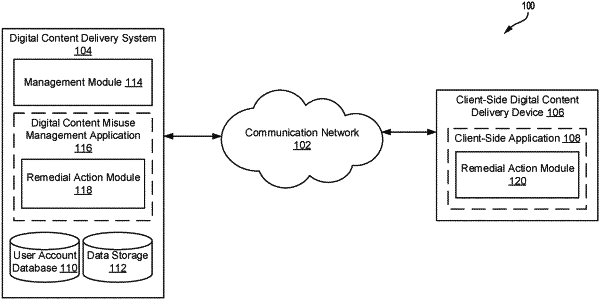| CPC G06F 21/10 (2013.01) [G06F 21/105 (2013.01); G06F 21/31 (2013.01); G06F 21/42 (2013.01); G06F 21/44 (2013.01); G06F 21/60 (2013.01); G06K 7/1417 (2013.01); G06Q 30/0635 (2013.01); G06Q 50/184 (2013.01); H04L 63/10 (2013.01); H04L 63/107 (2013.01); H04L 67/00 (2013.01); H04L 67/10 (2013.01); H04L 67/52 (2022.05); H04W 4/029 (2018.02); G06F 2221/0775 (2013.01); G06F 2221/2101 (2013.01); G06F 2221/2111 (2013.01)] | 21 Claims |

|
1. A method comprising:
detecting that a client-side computing device has been initially paired to a viewing device that is separate from the client-side computing device, wherein pairing the client-side computing device to the viewing device creates a communication interface between the client-side computing device and the viewing device and enables the client-side computing device to cause digital movies received from a remote server to be transmitted to the viewing device via the communication interface and presented on a display of the viewing device;
receiving, via the communication interface, a unique identifier associated with the viewing device;
storing the unique identifier in a memory to assign the viewing device as being authorized to operate with the client-side computing device to present digital movies received by the client-side computing device from the remote server;
after detecting that the client-side computing device has been initially paired to the viewing device, receiving a request to cause presentation of a first digital movie;
in response to receiving the request, requesting, via a current communication interface between the client-side computing device and a viewing device that is currently paired to the client-side computing device, a unique identifier of the viewing device that is currently paired to the client-side computing device;
determining that the unique identifier of the viewing device that is currently paired to the client-side computing device does not match the stored unique identifier indicating that the viewing device that is currently paired to the client-side computing device is not the viewing device that was assigned as being authorized to operate with the client-side computing device to present digital movies received by the client-side computing device from the remote server;
in response to determining that the unique identifier of the viewing device that is currently paired to the client-side computing device does not match the stored unique identifier, denying the request to cause presentation of the first digital movie.
|